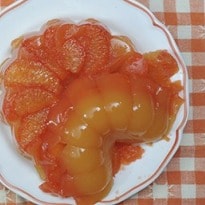Our new series on basic cooking skills opens with how to make jelly - from scratch
Serving jelly used to be a form of boasting. It was so incredibly difficult to do. You had to use starch made out of dried ground orchid root, or boil up fruit to get at the pectin, or get the jelly out of the swim bladder of a sturgeon or the grated shavings of a baby deer's velvet-soft antlers. Putting a jelly on the table was a way of letting the world know that you had troops of servants doing complicated things below stairs. It was all quite a faff.
These days, making jelly couldn't be easier. You buy a crisp, clear leaf of gelatine from the supermarket, soak it in warm water, mix it with juice and set it in the fridge. Yet it still has the feeling of magic, or alchemy - pig's trotter turned into juddering, shimmering gold.
When I was a child, my mum always made jellies for special occasions, such as birthdays or dinner parties. Perfect happiness was the "schhhhop" of suction as the first spoonful was served up, the pouring of single cream over the bowl, the joyful sluicing of jelly back and forth between one's front teeth.
If you are making today's recipe with children, they will enjoy the trick of suspending some fruit between the layers. If you are making it for grown-ups, try a more sophisticated unlayered jelly: simply add 1 tbsp Grand Marnier to the mix.
Either way, you must serve it with pouring cream (single, double, or whipping). Some things are too good to be left for the children.
Blood orange jelly
Skill level: basic
Prep time: 20 minutes
Chill time: 1 hour
Serves 3
300ml blood orange juice
25g caster sugar (1 tbsp)
3 sheets leaf gelatine
3 oranges
1 Gently heat the orange juice with the sugar in a pan until the sugar dissolves (but do not boil, as the gelatine will be less effective).
2 Soak all the gelatine leaves in a bowlful of cold water for about 5 minutes, or until they are soft and pliable. Remove from the soaking water and squeeze out any excess water with your hands. Stir into the warm blood orange juice.
3 Pour the blood orange juice through a sieve into a jug and tip half of it into a glass bowl. Place into the fridge to just set. This can take up to an hour depending on the temperature of your fridge.
4 While your jelly is setting, prepare your blood oranges by either segmenting them or cutting them across into pin wheels. Whatever method you use, the orange has to have its outer skin and pith removed. This can be done easily by cutting across the top and bottom of the orange, and cutting away the skin and pith by using downward strokes. (Any other fruit pieces could be used.)
5 Remove the bowl from the fridge and arrange the orange pieces on top of the set jelly before topping up with the rest of the blood orange juice. Return to the fridge to set.
6 You can serve up the jelly straight from the bowl and it will be utterly delicious. Don't forget the cream.
The next level
If you want to turn out the jelly for a bit of glorious wobbliness, use a jelly mould instead of a glass bowl in step 3. To turn it out, sit your bowl into another bowl or container filled with warm water to warm through the mould. Turn your bowl on to a serving plate and the jelly should drop onto it. If you have a stubborn jelly, just repeat the process.
For showing off
To make a layered jelly, as Joyce Molyneux did at the Carved Angel, do a layer using the ingredients above. Put in the fridge and when set, repeat the initial method, but this time use normal orange juice and blood orange pieces. You can layer this on top of your original blood orange one and add some chopped mint for extra flavour.
What else can you do?
You can repeat this method with other types of fruit juice and fruit pieces to make all kinds of jelly. Just repeat the quantities of juice and gelatin above, and add in raspberries, melon chunks or pomegranate seeds.
Recipe by Jane Baxter. Henry Dimbleby is co-founder of the natural fast-food restaurant chain Leon. (@henry_leon) Get your children cooking at cook5.
Photo: Well jel: blood orange jelly. Photography: Jill Mead for the Guardian














